Inclusive Tourism Adopted to Geosites: A Study in the Ajodhya Hills of West Bengal in India
Abstract
1. Introduction
- To review the rarity and diversity aspects, aesthetic appeal, and cultural values of hill-based and water-based geotourism sites in the Ajodhya hills;
- To enumerate the status of attractions and accessibilities of major geotourism sites of the Ajodhya hills from an inclusive tourism perspective;
- To evaluate the scope of planning to facilitate differently abled and elderly tourists in moderately and less accessible areas with highly attractive geotourism sites.
2. Study Area
- The plateau top, which is almost flat with isolated peaks and hillocks;
- The plateau rim, which is also called the break-of-slope zone;
- The piedmont zone at the foothill.
3. Materials and Methods
4. Results and Discussion
4.1. Major Hills as Geosites
4.2. Waterbodies with Attractive Rock Exposures
4.3. Major Waterfall Sites Drawing Geotourists
4.4. Springs of Ajodhya Hills as Geotourism Attraction
- Low attraction, High accessibility (LH): Unsuitable for inclusive tourism;
- Low attraction, Medium accessibility (LM): Unsuitable for inclusive tourism;
- Low attraction, Low accessibility (LL): Unsuitable for inclusive tourism planning;
- Medium attraction, High accessibility (MH): Provision of infrastructure may yield good results;
- Medium attraction, Medium accessibility (MM): Unsuitable for investment;
- Medium attraction, Low accessibility (ML): Unsuitable for investment;
- High attraction, High accessibility (HH): Conducive to inclusive tourism;
- High attraction, Medium accessibility (HM): Suitable for the immediate development of inclusive tourism;
- High attraction, Low accessibility (HL): Huge investment required for inclusive tourism development.
5. Conclusions
Author Contributions
Funding
Institutional Review Board Statement
Informed Consent Statement
Data Availability Statement
Conflicts of Interest
References
- Darcy, S.; Cameron, B.; Pegg, S. Accessible tourism and sustainability: A discussion and case study. J. Sustain. Tour. 2010, 18, 515–537. [Google Scholar] [CrossRef]
- Oliver, M.; Barnes, C. The New Politics of Disablement; Palgrave Macmillan: Hampshire, UK, 2012. [Google Scholar]
- Smith, R.W. Leisure of disabled tourists: Barriers to participation. Ann. Tour. Res. 1987, 14, 376–389. [Google Scholar] [CrossRef]
- Sirgy, M. Toward a quality-of-life theory of leisure travel satisfaction. J. Travel Res. 2010, 49, 246–260. [Google Scholar] [CrossRef]
- Scheyvens, R.; Biddulph, R. Inclusive tourism development. Tour. Geogr. 2018, 20, 589–609. [Google Scholar] [CrossRef]
- Gillovic, B.; McIntosh, A. Accessibility and Inclusive Tourism Development: Current State and Future Agenda. Sustainability 2020, 12, 9722. [Google Scholar] [CrossRef]
- Paga′n, R. Time allocation in tourism for people with disabilities. Ann. Tour. Res. 2012, 39, 1514–1537. [Google Scholar] [CrossRef]
- Kotlyarova, O.A.; Nekhoroshikh, N.A.; Povalyaeva, O.N.; Strelnikova, M.A. Inclusive tourism as a factor of sustainable development of the territories. E3S Web Conf. 2020, 208, 05011. [Google Scholar] [CrossRef]
- Münch, H.; Ulrich, R. Inclusive tourism. In The Long Tail of Tourism; Papathanassis, A., Ed.; Springer: Berlin/Heidelberg, Germany, 2011; pp. 159–169. [Google Scholar]
- Darcy, S. Tourism Patterns and Experiences of New South Wales People with a Physical Disability; Tourism New South Wales: Sydney, Australia, 1998. [Google Scholar]
- European Commission Enterprise and Industry. Tourism Accessibility. 2008. Available online: http://ec.europa.eu/enterprise/tourism/major_activities/accessible_tourism/index_en.htm. (accessed on 8 February 2023).
- Copperwiki.org. Disabled Tourism. Available online: http://www.copperwikLorg/index.php/Disabled_Tourism (accessed on 10 February 2023).
- Rebelo, S.; Patuleia, M.; Dias, Á. Inclusive Tourism: Assessing the Accessibility of Lisbon as a Tourist Destination. Tour. Hosp. 2022, 3, 466–495. [Google Scholar] [CrossRef]
- Bhattacharya, B.K.; Ray, P.; Chakraborty, B.R.; Sengupta, S.; Sen, N.N.; Sengupta, K.R.; Mukherji, S.; Sen, N.N.; Maity, T. West Bengal District Gazetteers: Puruliya; West Bengal Government: West Bengal, India, 1985. [Google Scholar]
- Bhattacharya, S. Ductile shear zone in Purulia. Indian J. Geol. 1989, 61, 172–178. [Google Scholar]
- Dasgupta, P. Rock characteristics and Susceptibility to weathering: A study in the metamorphic terrain of Ajodhya hill, West Bengal. J. Indian Geomorphol. 2015, 3, 27–47. [Google Scholar]
- Chakrabarty, P.; Mandal, R. Geotourism mapping for sustainability: A basin oriented approach. GeoJ. Tour. Geosites 2018, 21, 174–185. [Google Scholar]
- Panizza, M. Geomorphosites: Concepts, methods and examples of geomorphological survey. Chin. Sci. Bull. 2001, 46, 4–6. [Google Scholar] [CrossRef]
- Panizza, M.; Piacente, S. Geomorphological assets evaluation. Fur Geomorphol. N. F. Suppl. Bd. 1993, 87, 13–18. [Google Scholar]
- Reynard, E. Geosites. In Encyclopedia of Geomorphology; Goudie, A.S., Ed.; Routledge: London, UK, 2004; p. 440. [Google Scholar]
- Ruban, D.A.; Kuo, I. Essentials of geological heritage site (geosite) management: A conceptual assessment of interests and conflicts. Nat. Nascosta 2010, 41, 16–31. [Google Scholar]
- Wimbledon, W.A.P. GEOSITES—A new conservation initiative. Episodes 1999, 19, 87–88. [Google Scholar] [CrossRef]
- Ilieş, D.C.; Josan, N. Geosites-Geomorphosites and Relief. GeoJ. Tour. Geosites 2009, 3, 78–85. [Google Scholar]
- Gray, M. Geodiversity and geoconservation: What, why, and how? George Wright Forum 2005, 22, 4–12. [Google Scholar]
- Brocx, M.; Semeniuk, V. Geoheritage and geoconservation-history, definition, scope and scale. J. R. Soc. West. Aust. 2007, 90, 53–87. [Google Scholar]
- Predrag, D.; Mirela, D. Inventory of geoheritage sites—The base of geotourism development in Montenegro. Geographicapannonica 2010, 14, 126–132. [Google Scholar]
- Ruban, D.A. Quantification of geodiversity and its loss. Proc. Geol. Assoc. 2010, 121, 326–333. [Google Scholar] [CrossRef]
- Yusry, M.; Simon, N.; Unjah, T. Geodiversity and geoheritage assessment in Hulu Langat District, Selangor, Malaysia. GeoJ. Tour. Geosites 2018, 23, 861–872. [Google Scholar]
- Zouros, N.C. Geomorphosite assessment and management in protected areas of Greece case study of the Lesvos island—Costal geomorphosites. Geogr. Helv. 2007, 62, 169. [Google Scholar] [CrossRef]
- Dey, A.; Karmakar, S.; Ibanez-Mejia, M.; Mukherjee, S.; Sanyal, S.; Sengupta, P. Petrology and geochronology of a suite of pelitic granulites from parts of the Chotanagpur Granite Gneiss Complex, eastern India: Evidence for Stenian-Tonian reworking of a late Paleoproterozoic crust. Geol. J. 2020, 55, 2851–2880. [Google Scholar] [CrossRef]
- Ghosh, A.; Mukhopadhyay, S.; Chatterjee, S. Assessment of geoheritage and prospects of geotourism: An approach to geoconservation of important geological and geomorphological sites of Puruliya district, West Bengal, India. Int. J. Geoherit. Parks 2021, 9, 264–283. [Google Scholar] [CrossRef]
- Nag, S.K.; Chakraborty, S. Influence of rock types and structures in the development of drainage network in hard rock area. J. Indian Soc. Remote Sens. 2003, 31, 25–35. [Google Scholar] [CrossRef]
- Guha, S.; Patel, P.P. Evidence of topographic disequilibrium in the Subarnarekha River Basin, India: A digital elevation model based analysis. J. Earth Syst. Sci. 2017, 126, 1–20. [Google Scholar] [CrossRef]
- Ghosh, A.; Mukhopadhyay, S. Evaluation of springs and waterfalls as Geomorphosites and proposition of strategies to develop Geotourism at Ajodhya hill, Puruliya district, Eastern India. Geojournal 2022, 87, 1047–1067. [Google Scholar] [CrossRef]
- Sen, S. 41 Women Being the Tourist Guide of Pakhi Pahar in Purulia. 2023. Available online: https://www.sangbadpratidin.in/lifestyle/travel/41-women-being-the-tourist-guide-of-pakhi-pahar-in-purulia/ (accessed on 23 March 2023).
- Mawdsley, E. Development update: Domestic tourism. Geogr. Rev. 2009, 22, 32–33. [Google Scholar]
- Scheyvens, R. Poor cousins no more valuing the development potential of domestic and diaspora tourism. Prog. Dev. Stud. 2007, 7, 307–325. [Google Scholar] [CrossRef]
- Rains, S. Inclusive Tourism: A New Strategic Alliance for the Disability Rights Movement, ICAT. 2007. Available online: http://www.e-bility.com/articles/inclusive-tourism.php (accessed on 20 February 2023).
- Zsarnoczky, M. Accessible tourism in the European Union. In Proceedings of the 6th Central European Conference in Regional Science Conference Proceedings: “Engines of Urban and Regional Development”, Banska Bystrica, Slovakia, 20–22 September 2017; Faculty of Economics, Matej Bel University in Banská Bystrica: Banská Bystrica, Slovakia, 2017; pp. 30–39. [Google Scholar]
- Bakker, M.; Messerli, H.R. Inclusive growth versus pro-poor growth: Implications for tourism development. Tour. Hosp. Res. 2017, 17, 384–391. [Google Scholar] [CrossRef]
- Rogerson, C.M. In search of inclusive tourism in South Africa: Some lessons from the international experience. In New Directions in South African Tourism Geographies; Rogerson, J.M., Visser, G., Eds.; Springer: Cham, Switzerland, 2020. [Google Scholar]
- Calheiros, F. Inclusive tourism: A priority for Portugal. Worldw. Hosp. Tour. Themes 2020, 12, 715–717. [Google Scholar] [CrossRef]
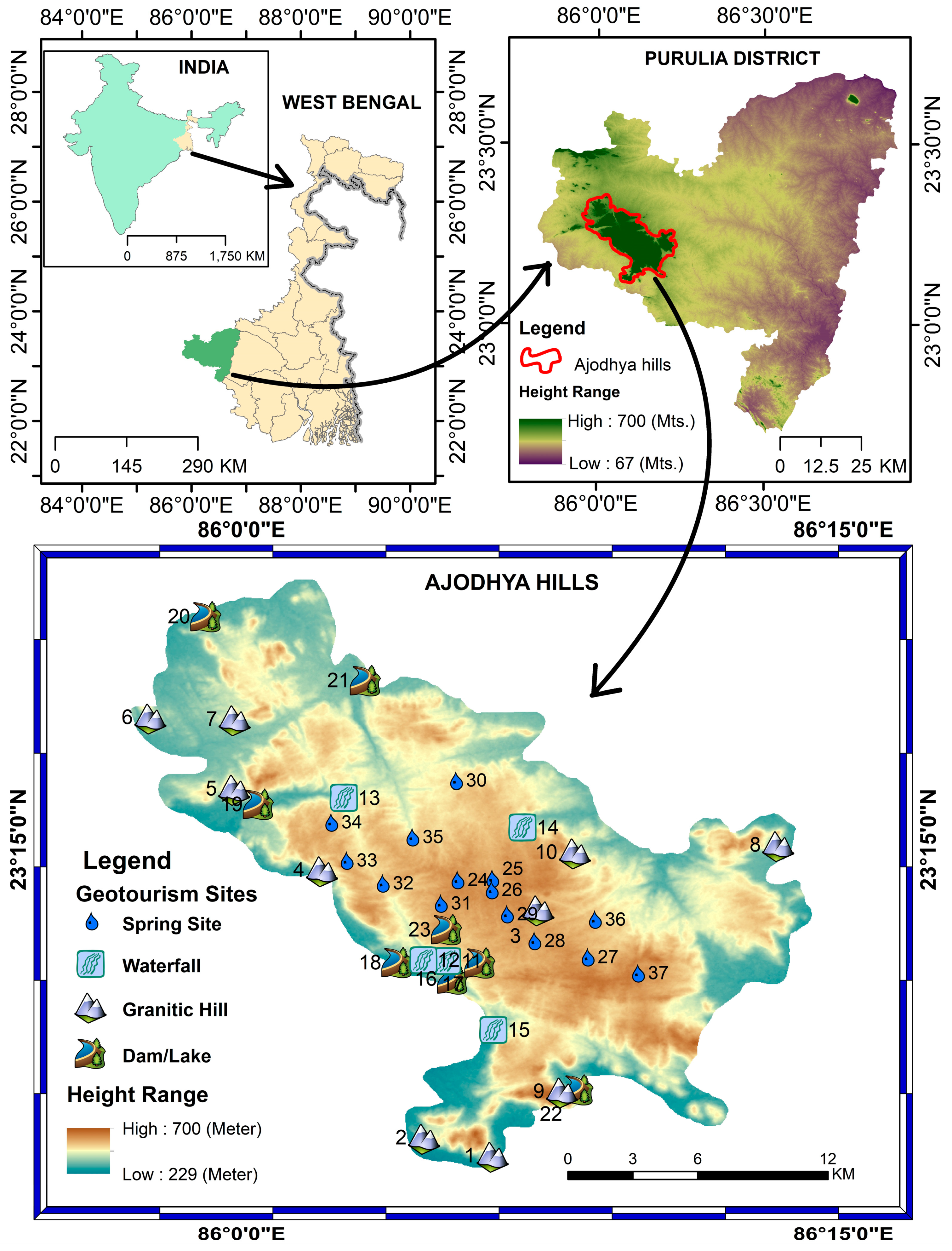

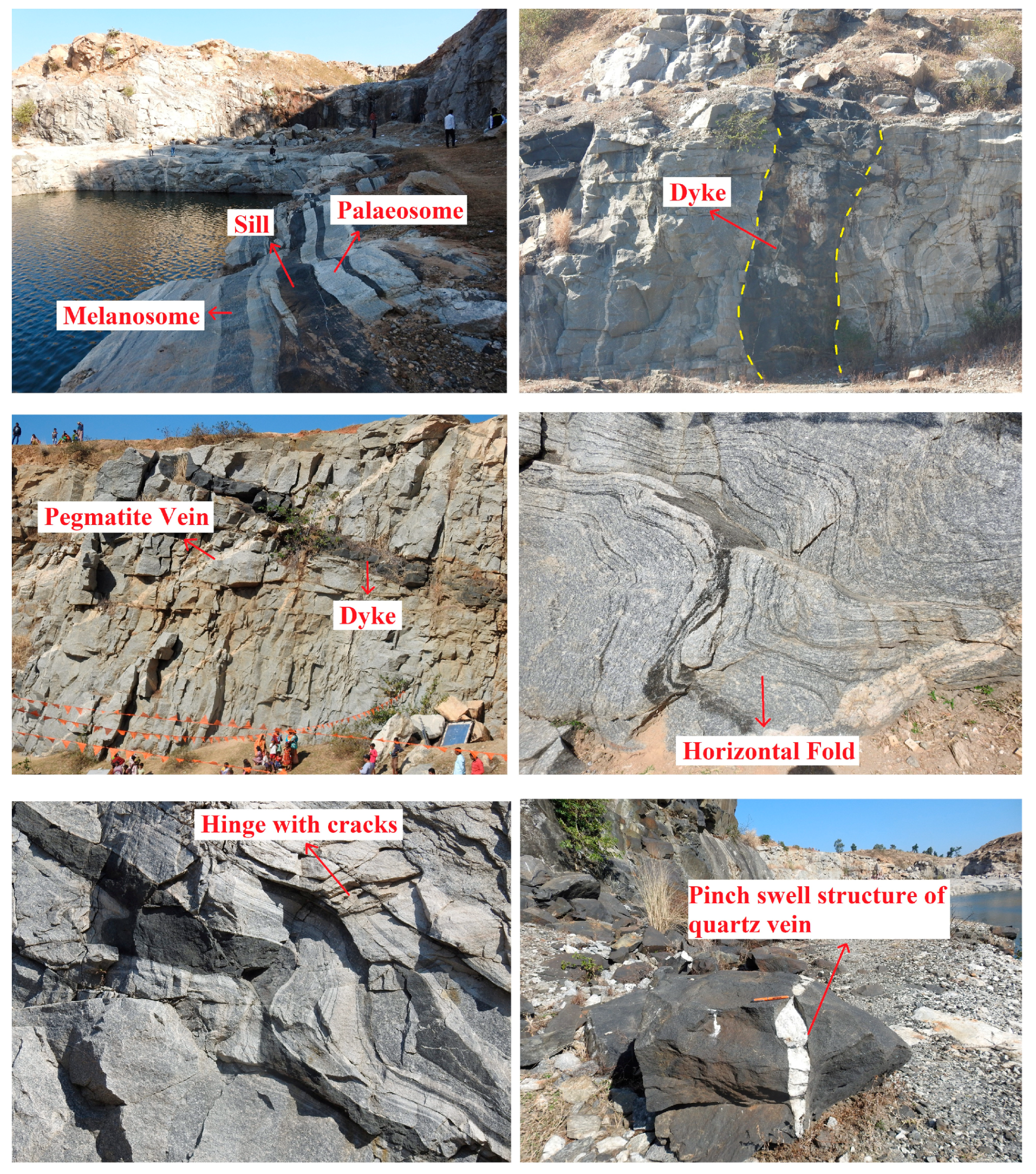
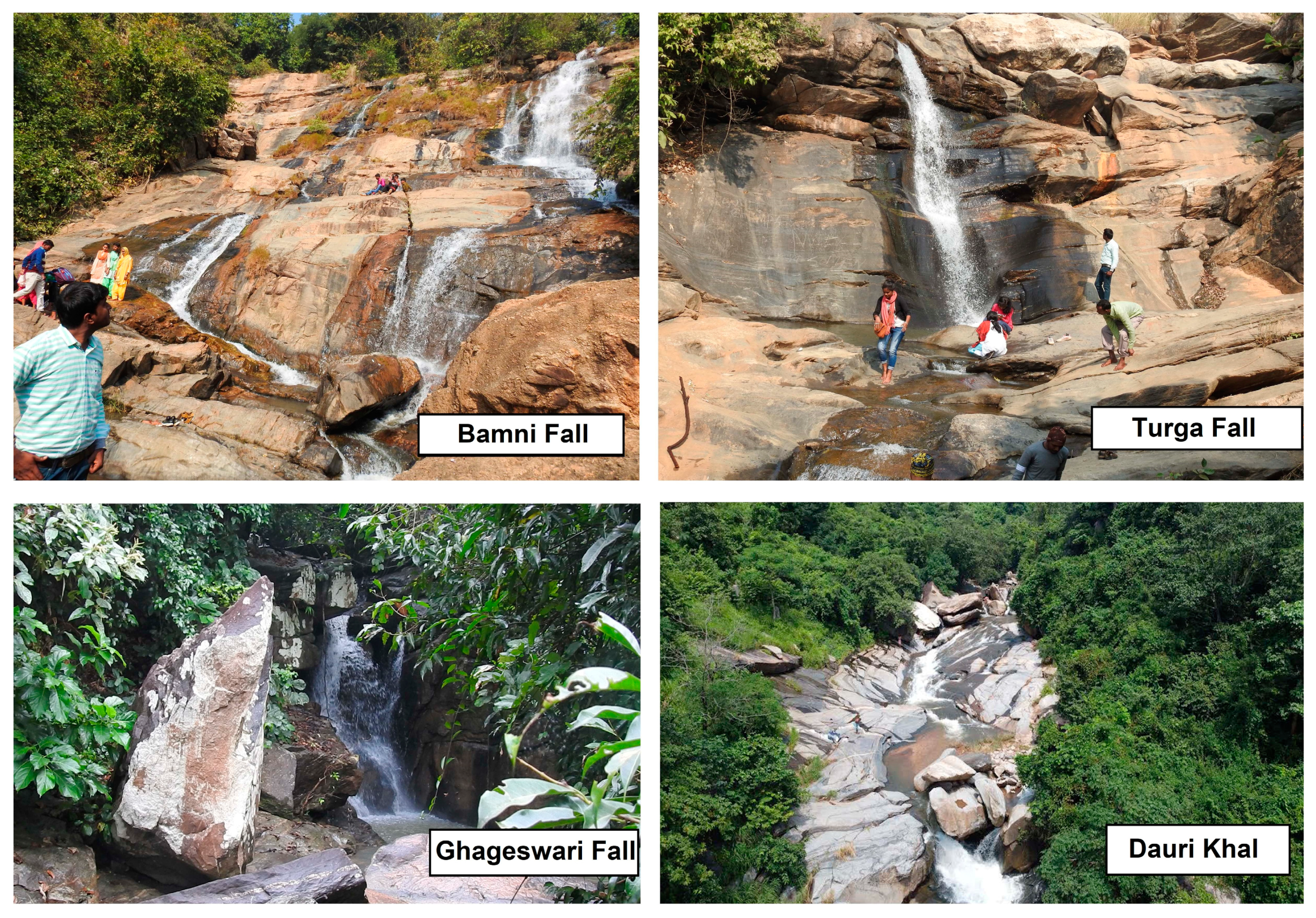
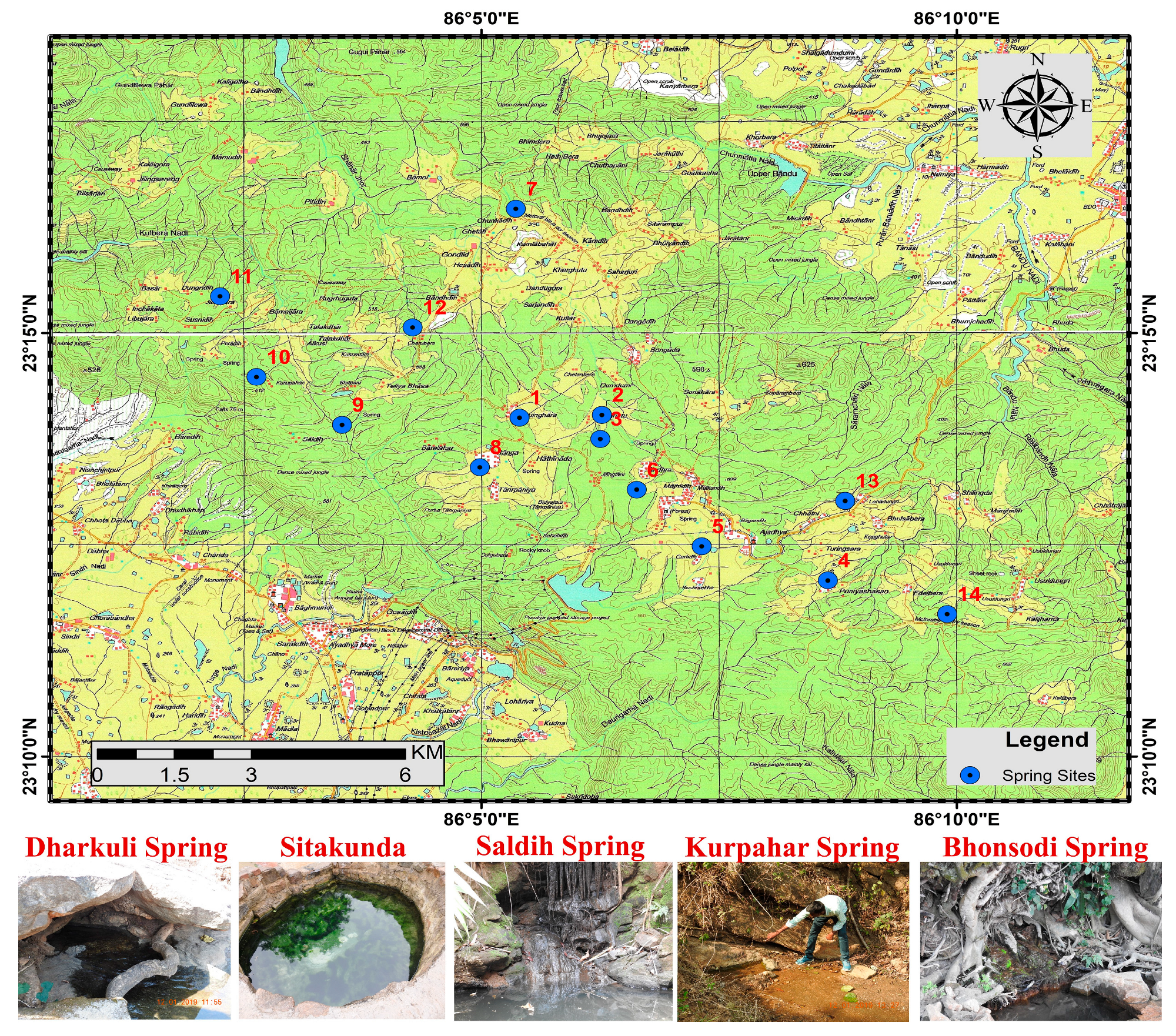
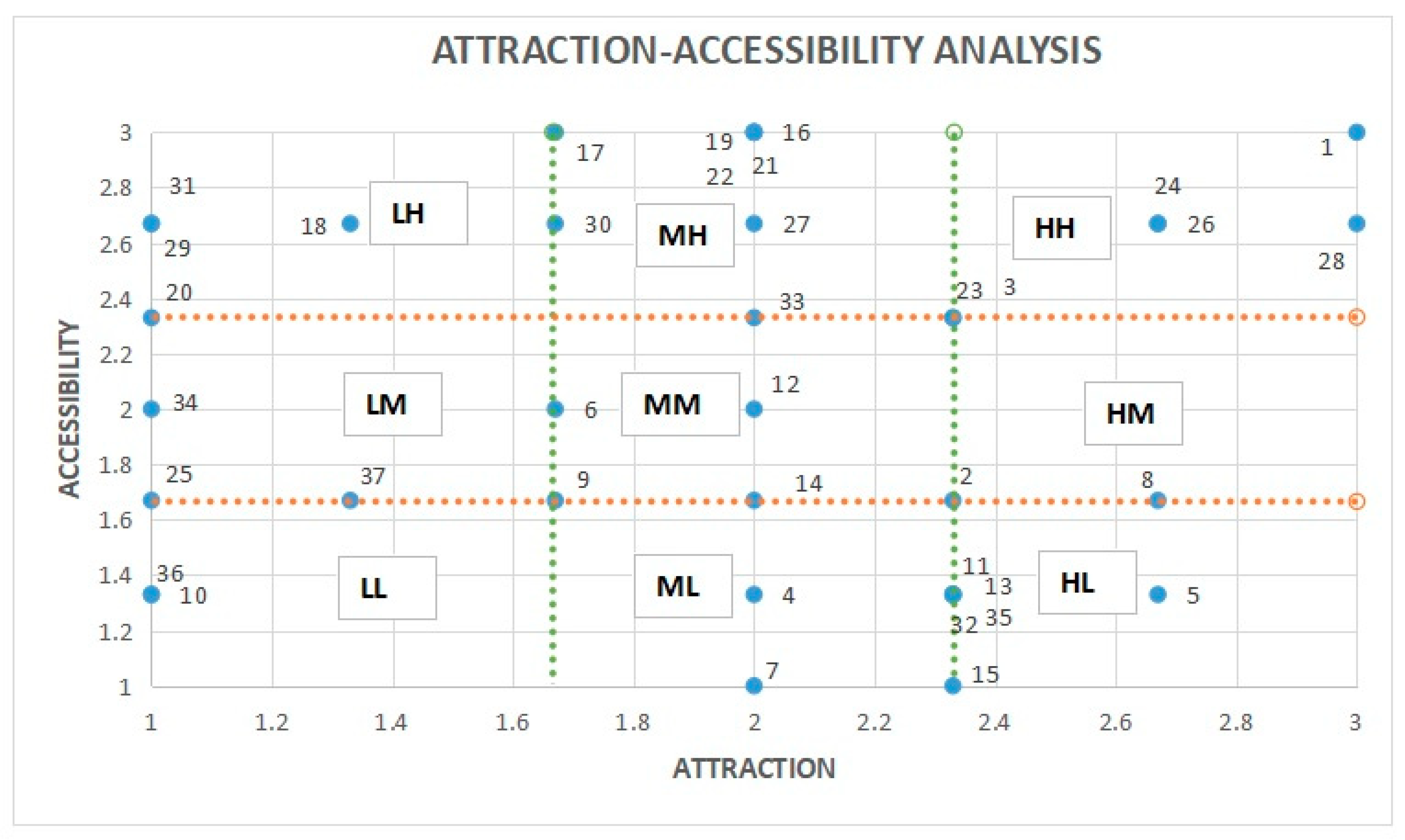
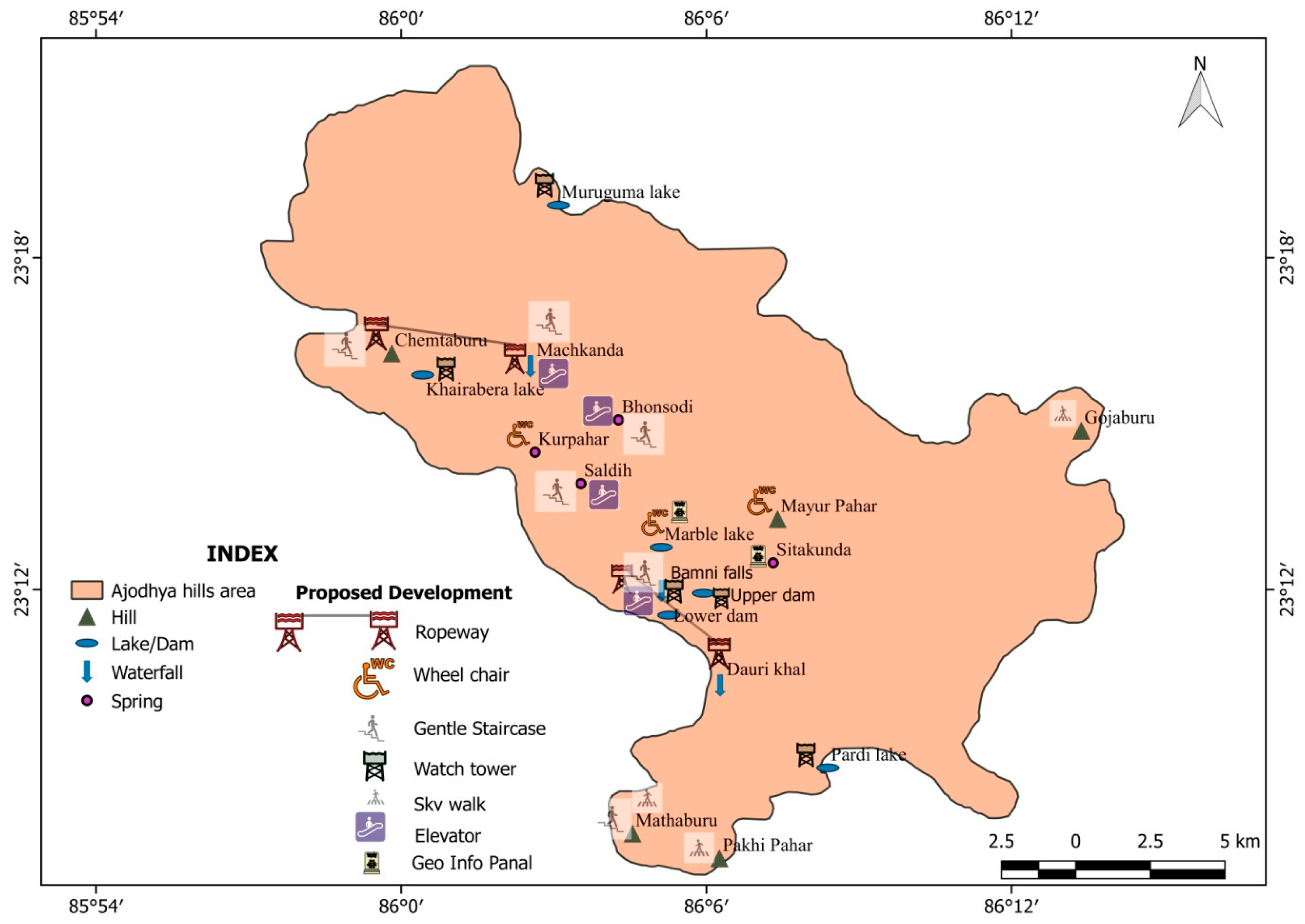
| Criteria | Sub-Criteria | Three Point Rating Scale | ||
|---|---|---|---|---|
| 1 | 2 | 3 | ||
| Accessibility | Access of vehicle to geotourism attraction point | >1 km from nearby road | <1 km, but more than 500 mts. | <500 mts. |
| Access path to geotourism attraction point | Steep Staircase/No stair | Gentle Staircase/Foot path | Tourist tract suitable for wheel chair access | |
| Access to geotourism attraction point | Difficult slope (Moderate to steep i.e., >10 to 25 degree) | Gentle to Moderate Slope (>2 to 10 degree) | Level Slope (0–2 degree) | |
| Attraction | Rarity and Diversity | Ordinary | Conspicuous | Unique |
| Aesthetic appeal | Low | Medium | High | |
| Cultural value | Negligible | Significant for association with belief system | Outstanding for mythology/ folklore | |
| Sl. No. | Name of Hills | Height (m) | Rarity & Diversity | Aesthetic Appeal | Cultural Values |
|---|---|---|---|---|---|
| 1 | Gorgaburu | 642 | Ordinary | Medium | Significant: association with belief system |
| 2 | Pakhi Pahar | 480 | Unique | High | Outstanding: known for rock art painted over it |
| 3 | Mathaburu | 478 | Conspicuous | Medium | Outstanding: for mythology/folklore |
| 4 | Chemtaburu | 700 | Unique | High | Significant: association with belief system |
| 5 | Ganjaburu | 602 | Conspicuous | Medium | Outstanding: for mythology/folklore |
| 6 | Jajahatu | 575 | Conspicuous | Medium | Negligible |
| 7 | Kuhuburu | 468 | Conspicuous | Medium | Outstanding: for mythology/folklore |
| 8 | Gojaburu | 585 | Conspicuous | High | Outstanding: for mythology/folklore |
| 9 | Chandni Pahar | 620 | Ordinary | Low | Negligible |
| 10 | Mayur Pahar | 598 | Conspicuous | High | Significant: association with belief system |
| Sl. No. | Name | Area (Approx.) in sq.km. | Rarity & Diversity | Aesthetic Appeal | Cultural Values |
|---|---|---|---|---|---|
| 1 | Muruguma lake | 0.80 | Conspicuous | High | Negligible |
| 2 | Norahara dam | 0.03 | Ordinary | Low | Negligible |
| 3 | Khairabera lake | 0.38 | Conspicuous | High | Negligible |
| 4 | Turga dam | 0.19 | Ordinary | High | Negligible |
| 5 | PPSP Upper dam | 0.98 | Conspicuous | Medium | Negligible |
| 6 | PPSP Lower dam | 0.32 | Conspicuous | High | Negligible |
| 7 | Durgabera dam (Marble lake) | 0.02 | Unique (spectacular geological features to see) | High | Negligible |
| 8 | Pardi lake | 0.07 | Conspicuous | High | Negligible |
| Sl. No. | Name | Approx. Height (in meter) | Approx. Width (in meter) | Rarity & Diversity | Aesthetic Appeal | Cultural Value |
|---|---|---|---|---|---|---|
| 1 | Bamni Waterfall (Cascading/Horse tail) | 52 | 11 | Unique | High | Negligible |
| 2 | Turga Waterfall (Cascading) | 22 | 10.5 | Conspicuous | High | Negligible |
| 3 | Machkanda Waterfall (Cascading/Horse tail) | 50 | 6 | Unique | High | Negligible |
| 4 | Ghageswari Waterfall (Cascading) | 26 | 5 | Conspicuous | High | Negligible |
| 5 | Dauri khal (Rapid) | 24 | 6 | Unique | High | Negligible |
| Sl. No. | Name of the Spring | Stream Originated | Height From msl (mts.) | Rarity & Diversity | Aesthetic Appeal | Cultural Value |
|---|---|---|---|---|---|---|
| 1 | Bhuigara | Hensadi | 578 | Unique | High | Significant: association with belief system |
| 2 | Shimulghutu | Sahar Jhor | 552 | Ordinary | Low | Negligible |
| 3 | Dharkuli | Sahar Jhor | 585 | Unique | High | Significant: association with belief system |
| 4 | Puniasasan | Bandu | 548 | Conspiuous | Medium | Significant: association with belief system |
| 5 | Sitakunda | Kistobazar | 425 | Unique | High | Strong mythological connection |
| 6 | Andhra | Kistobazar | 590 | Ordinary | Low | Negligible |
| 7 | Chunkati | Chunmatia Nala | 500 | Conspiuous | Medium | Negligible |
| 8 | Ranga | Turga | 566 | Ordinary | Low | Negligible |
| 9 | Saldih | Saldih | 525 | Unique | High | Negligible |
| 10 | Kurpahar | Kulbera | 511 | Conspiuous | High | Negligible |
| 11 | Jilingara | Kulbera | 508 | Ordinary | Low | Negligible |
| 12 | Bhonsodi | Sahar Jhor | 522 | Unique | High | Negligible |
| 13 | Chatni | Unnamed Stream | 502 | Ordinary | Low | Negligible |
| 14 | Edelbera | Kumari River | 582 | Ordinary | Medium | Negligible |
| Sl. No. | Geosite Name | Attraction (Mean) | Accessibility (Mean) | Category (***) |
|---|---|---|---|---|
| 1 | Pakhi Pahar | 3.00 | 3.00 | HH |
| 2 | Mathaburu | 2.33 | 1.67 | HM |
| 3 | MayurPahar | 2.33 | 2.33 | HH |
| 4 | Kuhuburu | 2.0 | 1.33 | ML |
| 5 | Chemtaburu | 2.67 | 1.33 | HL |
| 6 | Jajahatu | 1.67 | 2.00 | MM |
| 7 | Ganjaburu | 2.00 | 1.00 | ML |
| 8 | Gojaburu | 2.67 | 1.67 | HM |
| 9 | Gorgaburu | 1.67 | 1.67 | MM |
| 10 | Chandni Pahar | 1.00 | 1.33 | LL |
| 11 | Bamni falls | 2.33 | 1.33 | HL |
| 12 | Turga falls | 2.00 | 2.00 | MM |
| 13 | Machkanda falls | 2.33 | 1.33 | HL |
| 14 | Ghageswari falls | 2.00 | 1.67 | MM |
| 15 | Dauri khal | 2.33 | 1.00 | ML |
| 16 | Lower dam | 2.00 | 3.00 | MH |
| 17 | Upper dam | 1.67 | 3.00 | MH |
| 18 | Turga dam | 1.33 | 2.67 | LH |
| 19 | Khairabera dam | 2.00 | 3.00 | MH |
| 20 | Norahara dam | 1.00 | 2.33 | LH |
| 21 | Muruguma dam | 2.00 | 3.00 | MH |
| 22 | Pardi Lake | 2.00 | 3.00 | MH |
| 23 | Marble Lake | 2.33 | 2.33 | HH |
| 24 | Bhuigara | 2.67 | 2.67 | HH |
| 25 | Shimulghutu | 1.00 | 1.67 | LM |
| 26 | Dharkuli | 2.67 | 2.67 | HH |
| 27 | Puniasasan | 2.00 | 2.67 | MH |
| 28 | Sitakunda | 3.00 | 2.67 | HH |
| 29 | Andhra | 1.00 | 2.67 | LH |
| 30 | Chunkati | 1.67 | 2.67 | MH |
| 31 | Ranga | 1.00 | 2.67 | LH |
| 32 | Saldih | 2.33 | 1.33 | HL |
| 33 | Kurpahar | 2.00 | 2.33 | MH |
| 34 | Jilingara | 1.00 | 2.00 | LM |
| 35 | Bhonsodi | 2.33 | 1.33 | HL |
| 36 | Chatni | 1.00 | 1.33 | LL |
| 37 | Edelbera | 1.33 | 1.67 | LM |
Disclaimer/Publisher’s Note: The statements, opinions and data contained in all publications are solely those of the individual author(s) and contributor(s) and not of MDPI and/or the editor(s). MDPI and/or the editor(s) disclaim responsibility for any injury to people or property resulting from any ideas, methods, instructions or products referred to in the content. |
© 2023 by the authors. Licensee MDPI, Basel, Switzerland. This article is an open access article distributed under the terms and conditions of the Creative Commons Attribution (CC BY) license (https://creativecommons.org/licenses/by/4.0/).
Share and Cite
Ghosh, A.; Mandal, R.; Chakrabarty, P. Inclusive Tourism Adopted to Geosites: A Study in the Ajodhya Hills of West Bengal in India. Tour. Hosp. 2023, 4, 321-335. https://doi.org/10.3390/tourhosp4020020
Ghosh A, Mandal R, Chakrabarty P. Inclusive Tourism Adopted to Geosites: A Study in the Ajodhya Hills of West Bengal in India. Tourism and Hospitality. 2023; 4(2):321-335. https://doi.org/10.3390/tourhosp4020020
Chicago/Turabian StyleGhosh, Avijit, Rahul Mandal, and Premangshu Chakrabarty. 2023. "Inclusive Tourism Adopted to Geosites: A Study in the Ajodhya Hills of West Bengal in India" Tourism and Hospitality 4, no. 2: 321-335. https://doi.org/10.3390/tourhosp4020020
APA StyleGhosh, A., Mandal, R., & Chakrabarty, P. (2023). Inclusive Tourism Adopted to Geosites: A Study in the Ajodhya Hills of West Bengal in India. Tourism and Hospitality, 4(2), 321-335. https://doi.org/10.3390/tourhosp4020020







